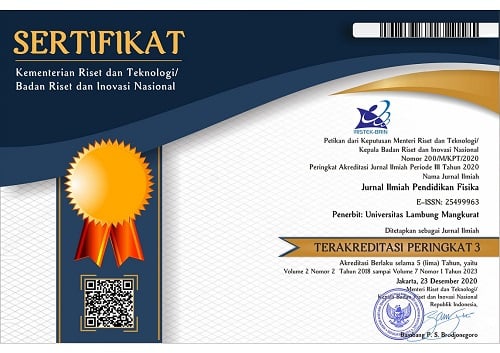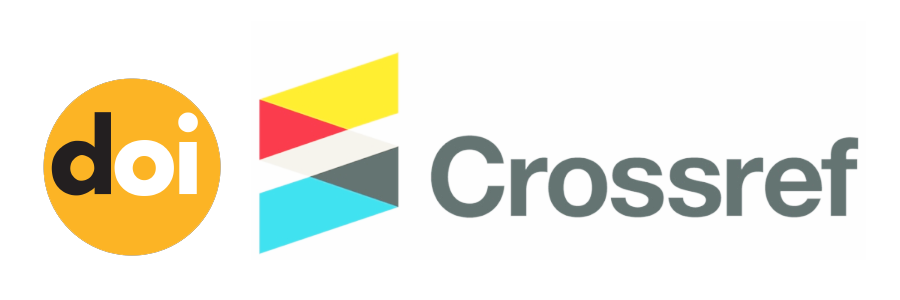Flipped Classroom Meta-Analysis of Critical Thinking Skills and Learning Outcomes in High School Physics Learning
Abstract
The main objective of this research is to analyze the effect of the flipped classroom on critical thinking skills and learning outcomes in high school physics learning. This study's specific objective is to determine the effect size and the influence of research characteristics from various literature articles. The population in this study amounted to 21 research articles, and then the research sample was taken from the population using a purposive sampling technique. The research instrument used coding sheets. The results of the meta-analysis of this study indicated that the flipped classroom could affect critical thinking skills and student learning outcomes in high school physics learning. The average effect size of the flipped classroom model on critical thinking skills in high school physics learning was 1.964, and the average effect size of the flipped classroom model on learning outcomes in high school physics learning was 2.058. This study analyzed eight research characteristics in the article that were thought to influence critical thinking skills and learning outcomes. Among them were the gender of the researcher, the research university, the research location, the physics material, the type of research, the sample size used, data collection tools, and statistical tests. The results of the analysis showed the characteristics of research articles that influence critical thinking skills and learning outcomes: sample size, researcher's gender, data collection tools, and materials, making these characteristics need to be considered in research.
Keywords
Full Text:
PDFReferences
Agung, S. (2010). Studi deskriptif effect size penelitian penelitian di fakultas psikologi universitas sanata dharma. Jurnal Penelitian Universitas Sanata Dharma, 10(1).
Alwi, I. (2015). Kriteria Empirik Dalam Menentukan Ukuran Sampel Pada Pengujian Hipotesis Statistika Dan Analisis Butir. Jurnal Formatif, 2(2), 140–148.
Anam, A. (2020). Spiritual Emotional Freedom Technique (SEFT) untuk menurunkan tingkat kecemasan pada pasien hipertensi. UnSoed.
Anggreni, Y. D., Festiyed, F., & Asrizal, A. (2019). Meta-analisis pengaruh model pembelajaran project based learning terhadap kemampuan berpikir kritis peserta didik SMA. Pillar Of Physics Education, 12(4).
Anisa, A. R., Ipungkarti, A. A., & Saffanah, K. N. (2021). Pengaruh kurangnya literasi serta kemampuan dalam berpikir kritis yang masih rendah dalam pendidikan di Indonesia. Current Research in Education: Conference Series Journal, 1(1).
Arnyana, I. B. P. (2019). Pembelajaran untuk meningkatkan kompetensi 4c (communication, collaboration, critical thinking dancreative thinking) untuk menyongsong era abad 21. Prosiding: Konferensi Nasional Matematika dan IPA Universitas PGRI Banyuwangi, 1(1).
Ashari, M. R., & Basuki, I. (2021). Keefektifan model pembelajaran flipped classroom untuk meningkatkan hasil belajar peserta didik pada mata pelajaran dasar listrik dan elektronika di smk. Jurnal Pendidikan Teknik Elektro, 10(02), 49-58.
Bergmann, J., & Sams, A. (2012). Flipped your classroom: Reach every student in every class every day. ISTE & ASCD.
Cabı, E. (2018). The impact of the flipped classroom model on students' academic achievement. International Review of Research in Open and Distributed Learning, 19(3).
Emily R. L. (2011). Critical thinking: A Literature review research report. London: PEARSON
Ennis, R. H. (1989). Goal critical thinking curriculum. Dalam Costa, A. L. (Ed): Developing minds: a resourse book for teaching thinking. Association for Supervision and Curriculum Developing (ASCD).
Fuad, N. M., Zubaidah, S., Mahanal, S., & Suarsini, E. (2017). Improving junior high schools' critical thinking skills based on test three different models of learning. International Journal of instruction, 10(1), 101-116.
Glass, G. (2016). Meta-analysis of research on class size and achievement. American Educational Research Association, 1(1).
Hartini, S., Mariani, I., & Sulaeman, N. F. (2020, June). Developing of students worksheets through STEM approach to train critical thinking skills. Journal of Physics: Conference Series, 1567(4), 042029.
Johnson, E. B. (2009). Contextual teaching and learning (Edisi Terj). MLC.
Littell, J. H., Corcoran, J., & Pillai, V. (2008). Systematic reviews and meta-analysis. Pocket Guide to Social Work Re.
Kemendikbud. (2019). Hasil PISA Indonesia 2018: Akses Makin Meluas, Saatnya Tingkatkan Kualitas.
Kurnianto, B., Wiyanto, W., & Haryani, S. (2019). Critical thinking skills and learning outcomes by improving motivation in the Model of Flipped Classroom. Journal of Primary Education, 8(6), 282-291.
Listari, L. (2021). Penilaian dan hasil belajar. Enggang Media.
Mahanal, S., Zubaidah, S., Bahri, A., & Maratusy, D. S. (2016). Empowering students’ critical thinking skills through Remap NHT in biology classroom. Asia-Pacific Forum on Science Learning and Teaching, 17(2), 1-13.
Misbah, M., Mahtari, S., Wati, M., & Harto, M. (2018). Analysis of students' critical thinking skills in dynamic electrical material. Kasuari: Physics Education Journal (KPEJ), 1(2), 103-110.
Misbah, M., Hamidah, I., Sriyati, S, & Samsudin, A. (2022). A bibliometric analysis: research trend of critical thinking in science education. Journal of Engineering Science and Technology, 17, 118-126.
Nurhasanah, N. (2017). Pengaruh problem based learning pada hasil belajar fisika: Sebuah meta-analisis artikel jurnal online indonesia. Jurnal Pendidikan Dan Pembelajaran Khatulistiwa, 6(3).
Nurpianti, S., & Wijaya, A. F. C. (2019). Implementasi model flipped classroom berbasis pendidikan untuk pembangunan berkelanjutan (ppb) dalam meningkatkan keterampilan berpikir kritis. Prosiding Seminar Nasional Fisika, 1(1), 208-214.
Özdemir, A., & Şentürk, M. L. (2021). The effect of flipped classroom model on students'academic achievement in science and mathematics education: A meta-analysis study. Journal of Educational Technology, 18(3).
Partono, P., Wardhani, H. N., Setyowati, N. I., Tsalitsa, A., & Putri, S. N. (2021). Strategi meningkatkan kompetensi 4C (critical thinking, creativity, communication, & collaborative). Jurnal Penelitian Ilmu Pendidikan, 14(1), 41-52.
Pratiwi, R., Hikmawati, H., & Gunada, I. W. (2019). Pengaruh model pembelajaran probing prompting berbantuan video terhadap hasil belajar dan kemampuan berpikir kritis peserta didik. Jurnal Pendidikan Fisika dan Teknologi, 5(2), 213-220.
Putra, I. M. Y. T. (2021). Implementasi pembelajaran flipped classroom berbasis strategi diferensiasi untuk meningkatkan keterampilan berpikir kritis peserta didik. Indonesian Journal of Educational Development (IJED), 2(3), 461-471.
Rukajat, A. (2018). Pendekatan penelitian kuantitatif (1st ed.). Deepublish Publisher.
Septikasari, R., & Frasandy, R. N. (2018). Keterampilan 4C abad 21 dalam pembelajaran pendidikan dasar. Tarbiyah Al-Awlad: Jurnal Kependidikan Islam Tingkat Dasar, 8(2), 107-117.
Sugiyono. (2017). Metode penelitian pendidikan: Pendekatan kuantitatif, kualitatif dan R&D. alfabeta.
Sulistri, E. (2010). Efektivitas kegiatan remediasi untuk mengatasi miskonsepsi siswa: sebuah rangkuman meta-analisis Skripsi Mahasiswa Program Studi Pendidikan Fisika FKIP UNTAN 2009. Pontianak: FKIP UNTAN (thesis).
Supriatna, U. (2021). Flipped classroom: Metode pembelajaran tatap muka terbatas pada masa pandemi covid-19. Jurnal Ideas :Pendidikan, Sosial, Dan Budaya, 7(3). https://doi.org/10.32884
Sutrisno, L. (2007). Pengaruh problem based learning pada hasil belajar fisika: Sebuah meta-analisis artikel jurnal online indonesia. Jurnal Pendidikan Dan Pembelajaran Khatulistiwa, 6.
Wayudi, M., Suwatno, & Santoso, B. (2020). Kajian analisis keterampilan berpikir kritis siswa sekolah menengah atas. Jurnal Pendidikan Manajemen Perkantoran, 5(1), 67–82.
Yani, M., Mastuang, M., & Misbah, M. (2021). Development of solid elasticity modules with guided inquiry model to train critical thinking skills. Kasuari: Physics Education Journal (KPEJ), 4(1), 44-56.
DOI: https://doi.org/10.20527/jipf.v7i2.7924
Refbacks
- There are currently no refbacks.
Indexed by: Jurnal Ilmiah Pendidikan Fisika is licensed under a creative commons attribution-share alike 4.0 international license
Statistics Counter |
















